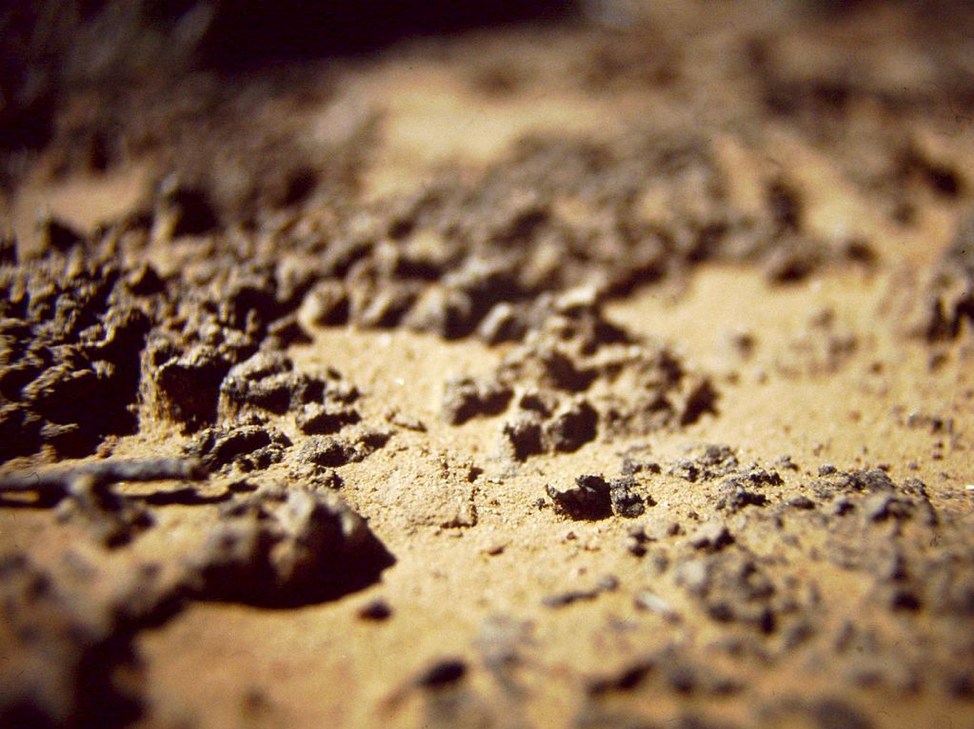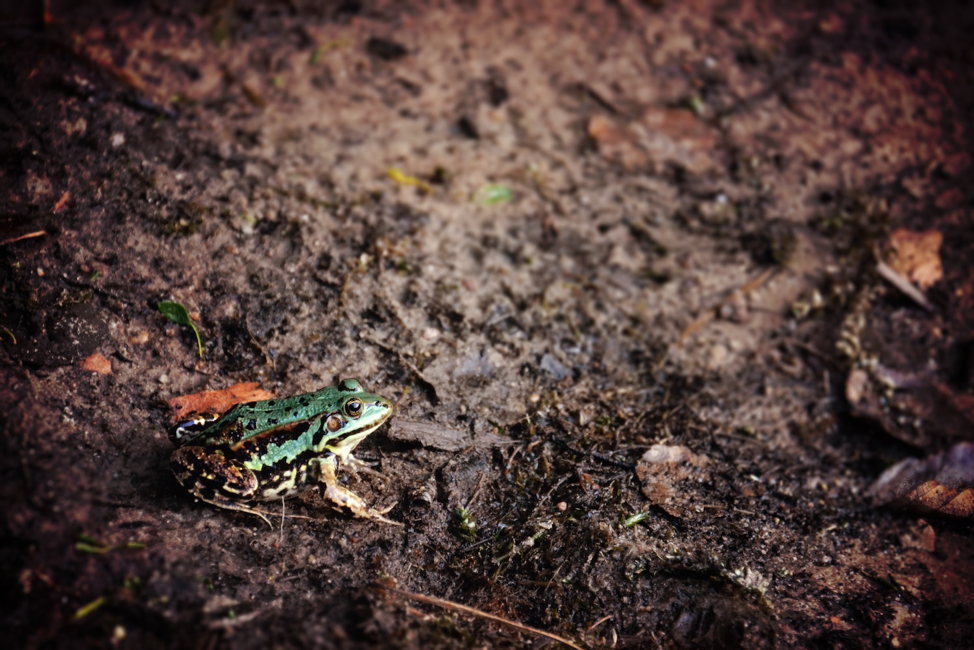The Importance of Cryptobiotic Soil and How Earth Law Can Help
Figure 1 Cryptobiotic soil at Arches National Park, Utah, USA. Henning Schlottmann.
By Hali Stuck
As I climbed up the red canyons and hiked through the brush and sand, I had to watch every step I took. Why? Because of cryptobiotic soil of course. Sounds like some sort of radiation term, doesn’t it?
It’s a special soil that only forms in arid areas such as the Colorado Plateau, Sonoran Desert, Great Basin, and the inner Columbia Basin. It can even be found in the Arctic! ‘Crypto,’ meaning hidden, and ‘bio,’ meaning life, is made up of five living organisms: cyanobacteria, lichens, mosses, green algae, and microfungi.
These organisms work together to form a hard black crust that helps prevent erosion, absorb rainfall, and provide nutrients for the growing plants around it.
Why cryptobiotic soil
The most accurate name for cryptobiotic soil is ‘biological soil crust,’ meaning “formed by living organisms and their by-products, creating a crust of soil particles bound together by organic material.”
You may also hear people call it ‘chemical’ or ‘physical’ crust, which is inaccurate because those are defined as inorganic features which is the opposite of what cryptobiotic soil is. Since this soil covers over 70% of the living ground in the arid Southwest, it comes in many different shapes and sizes and even has many different species of microorganisms in it depending on what area it is found in.
If you are in the Great Basin or the Colorado Plateau you may see smoother and wave-like cryptobiotic soil (or crypto for short). This is due to the large number of plant roots in those areas and most of the rainfall occurring in winter, which keep the crypto from swelling.
However, in southern arid areas such as the Sonoran and Mojave Deserts where there are fewer plant roots and also excessive, uneven erosion, the crypto has much higher and steeper pinnacles. Depending on how old the crypto is it can be anywhere from one centimeter to fifteen centimeters deep. The deeper crusts can be up to thousands of years old.
There is even research that has been done that says that crypto was one of the first living organisms on this planet dating back to 3.5 billion years ago.
Figure 2 Soil crust at base of Wyoming big sagebrush Seedskadee. USFWS Mountain-Prairie.
What Does Cryptobiotic Soil Do?
Cryptobiotic soil is the glue that holds the desert together. It gives plants a safe sturdy place to grow, it protects the earth below it from washing away during rain, and it keeps the life that can survive the deserts harsh conditions from blowing away and turning a once green area into rolling, barren sand dunes.
Rainfall
Rain may not fall often in the desert but when it does it can be intense. Erosion is one of the bigger issues that the desert faces due to the lack of sturdiness that the ground has in those areas. That’s where crypto comes into play. Crypto’s hard top layer gives sturdy protection to the soil below it as well as to the plants around it, guarding them from being washed away during harsh rainstorms. This top layer absorbs the rain, keeping the area around it from washing away, as well as making water available for dryer seasons.
When cryptobiotic soil is dry the organisms that it consists of lie dormant. When it rains, the mosses, lichens, cyanobacteria, algae, and fungi can move through the sand leaving behind a sheath on loose areas and creating the beginnings of new crypto.
Figure 3 Green frog in the rain. Photo by Jill Heyer on Unsplash.
Plant Life
Crypto also plays other roles in helping the plant life around it grow. Sand is not a great place for seeds to land. This loose substance causes plant seeds to get buried in areas that have little to no nutrients or it causes them to continuously blow through the wind, never rooting into the ground.
Crypto catches these seeds on its hard surface and gives them a safe, nutrient-rich area to grow. The dark color of crypto also keeps the ground that it grows on the right temperature for seed germination. Plants that thrive in the presence of crypto include Sixweeks Fescue, Desert Blazing Star, Rock-Cress Prostrate Summercypress, Blue Flax, Mountain Peppergrass, and Scarlet Globemallow.
However, some plants do not do well in crypto. The hardness of the top layer of crypto limits large seeds from burrowing and germinating. These large seeds are not usually native species, so crypto helps prevent invasive species from being able to grow and spread.
Nitrogen Fixation and Other Nutrients
Cryptobiotic soil also helps with the process of nitrogen fixation. Plants need nitrogen to assist in the creation of amino acids, proteins, and DNA. Without the help of nitrogen fixation, especially in the desert where there is very little access to nutrients, the fight for a plant to stay alive would be futile. Crypto contains denitrifying bacteria which assists in transforming the nitrogen in the atmosphere into a type of nitrogen that plants can use.
Crypto is the dominant source of nitrogen in the desert. Crypto’s hard top layer also provides a place for nutrients to cling to such as calcium, potassium, and manganese. These nutrients bind to the cryptobiotic soil and are in turn available to the plants around it.
Threats to Cryptobiotic Soil
Foot Traffic
The biggest threat that cryptobiotic soil faces is our very feet. Crypto is such an important piece of the desert, and it is extremely fragile. One bootprint can destroy hundreds, even thousands, of years of growth.
Livestock
The desert is not meant to sustain thousands of cattle moving through its plains and rolling hills. The excessive grazing and trampling of the native species turns thousands of miles of once-thriving lands into barren dunes.
Military Activities
The arid desert lands of North America are the perfect space for military activities, from testing new artillery to hosting bootcamps. Large areas of land has been opened up for “carte blanche” military use, which has resulted in mass destruction of the native species and miles of crypto.
Wildfires
Wildfires rage and gain media attention in California, but what about the ones in the arid deserts of North America? Utah is ranked one of the most wildfire-vulnerable states. One tiny little flame can spread across the desert countryside in a matter of minutes.
Entire valleys of plants are burnt to ash due to rampant fires, wiping out crypto. Crypto can survive low-intensity fires, but high-intensity fires can destroy miles of well-established crypto. The high density of sagebrush that grows in these regions provides fuel for fires, increasing the fire’s intensity.
How Long Does It Take Crypto to Recover?
Even though crypto is such a much-needed piece of the desert environment it is extremely fragile and takes a significant amount of time to recover. Crypto is most vulnerable when it is dry, which is most of the year due to the small amounts of rain the desert receives. When dry crypto is trampled by feet, livestock, ATV’s, and whatever else humans bring into the desert, it can take up to 250 years for that one patch to recover.
One patch of destroyed crypto can lead to sandblasting, which often buries other crypto-covered areas. Visual recovery can take 1-7 years in favorable conditions. After that, it can take up to 45 years for lichens to reappear and 250 years for mosses, meaning that if an area is destroyed today it can take up to eight generations for that area of crypto to be fully recovered as long as there are supportive conditions. In a matter of just a few years, that area will become sand dunes if the growing conditions are not favorable- barren, dry, and lifeless.
Figure 4 Sand replaces soil without crypto.
What Happens When the Crypto Is Gone?
A lack of Cryptobiotic Soil can lead to barren dunes, but what else happens when the crypto is destroyed and disappears? Biodiversity decreases due to the sudden lack of nutrients and lack of stability in the soil along with increased sandblasting which in turn covers nearby sections of crypto as well as other plants.
Lack of crypto also increases runoff by half which causes six times the amount of soil loss that usually occurs when crypto is present. When crypto is lacking, once harmless native plants can turn harmful. Plants such as Artemisia Tridentata, Atriplex Confertifolia, and Ceratoides Lanata can cause nitrogen fixation to decrease by 80%.
How Earth Law can help protect cryptobiotic soil
Rights of Nature can help protect cryptobiotic soil by recognizing the critical role that these fragile ecosystems play in the overall health of Nature and everything that depends on it (including us!). Earth Law includes us all in community in terms of securing the rights to live, thrive, and evolve. Cryptobiotic soil is currently an overlooked community member who we will badly miss when it’s gone.
Less an arid sand dune and more a desert ecosystem that is full of life, crypto hosts a community that Earth Law can help protect.
Earth Law Center works with local communities and organizations to recognize the Rights of Nature, and strengthen the legal protection of Nature’s ecosystems.
What you can do to protect Cryptobiotic Soil
Even though as humans we are the biggest contributors to cryptobiotic soil’s destruction, we can also be the biggest contributors to its survival. It’s almost easier to protect it than it is to destroy it. All it requires us to do is to be more conscious of where we step.
Figure 5 CGP Grey.
Stay on the Paths
It’s truly that simple. Stay in areas that have already been impacted by humans such as set trails for walking and ATV’s and established campgrounds.
Continue the Growth of Protected Lands
There are many lands in the arid desert regions that have the law on their side such as different national parks and protected lands, but what about the areas that aren’t protected? There are thousands of acres being destroyed every day that are full of cryptobiotic soil. Crypto is desperately needed in order for anything to grow in the desert. We must continue the efforts that have already begun and protect this key and extremely fragile aspect of desert lands.
Here’s more you can do:
Visit the virtual crypto library and learn more below:





